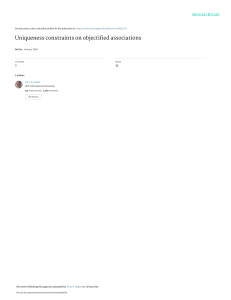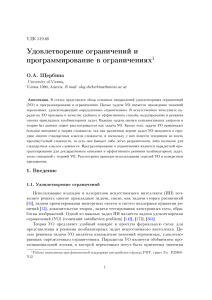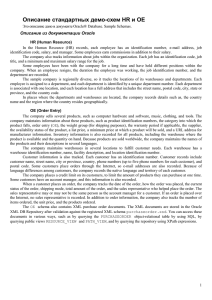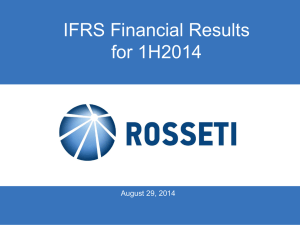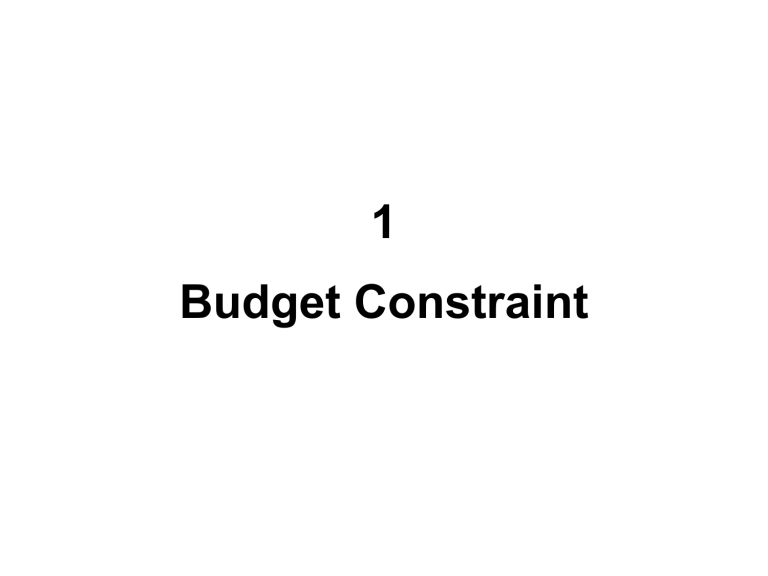
1
Budget Constraint
Topics
• Budget constraint. Budget set.
Budget line. Numéraire. Non-linear
budget constraints. Taxes, subsidies,
and rationing. Modeling composite
goods. Budget constraint with
endowment.
Reading
§ Varian [V], ch 2; Вэриан [В], гл 2
Budget Constraints
• A consumption bundle containing 𝑥1
units of commodity 1, 𝑥2 units of
commodity 2 and so on up to 𝑥𝑛 units of
commodity n is denoted by the vector
(𝑥1, 𝑥2, … , 𝑥𝑛).
• Commodity prices are 𝑝1, 𝑝2, … , 𝑝𝑛.
Budget Constraints
• A bundle (𝑥1, … , 𝑥𝑛) affordable at prices
𝑝1, … , 𝑝𝑛 when
𝑝1𝑥1 + ⋯ + 𝑝𝑛𝑥𝑛 ≤ 𝑚
where 𝑚 is the consumer’s (disposable)
income.
Budget Constraints
• The bundles that are only just affordable
form the consumer’s budget constraint or
budget set. This is the set
{(𝑥1, … , 𝑥𝑛)|𝑥1 ≥ 0, … , 𝑥𝑛 ≥ 0 and
𝑝1𝑥1 + ⋯ + 𝑝𝑛𝑥𝑛 ≤ 𝑚}
• Since most of our economic insights can be
derived by confining attention to the case of
two goods
{(𝑥1, 𝑥2)|𝑥1 ≥ 0, 𝑥2 ≥ 0 and
𝑝1𝑥1 + 𝑝2𝑥2 ≤ 𝑚}
Sometimes we will refer to the goods as 𝑥 and 𝑦 instead of 1 and 2. In that
case, per-unit prices will be written as 𝑝𝑥 and 𝑝𝑦
Budget Constraints
• The consumer’s budget set is the set of all
affordable bundles;
𝐵(𝑝! , 𝑝" , 𝑚) =
{(𝑥! , 𝑥" )|𝑥1 ≥ 0, 𝑥" ≥ 0 and
𝑝! 𝑥! + 𝑝" 𝑥" ≤ 𝑚}
which expresses the idea that the expenditure on good 1
(𝑝1𝑥1) and the expenditure on good 2 (𝑝2𝑥2) should not
exceed the consumer’s income.
• The upper boundary of the budget set is a
budget line:
{(𝑥! , 𝑥" ) ∈ ℝ"# |𝑝! 𝑥! + 𝑝" 𝑥" = 𝑚}
Budget Set for Two Commodities
𝒙𝟐
Vertical
intercept
𝑚/𝑝2
𝑝1𝑥1 + 𝑝2𝑥2 = 𝑚 is
𝑥2 = −(𝑝1/𝑝2)𝑥1 + 𝑚/𝑝2
so slope of budget line is −𝑝1/𝑝2
Budget line
Budget set
𝑚/𝑝1
𝒙𝟏
Horizontal
intercept
Budget Constraints
• The budget line’s slope is −𝑝1/𝑝2. What
does it mean?
𝑝1
𝑚
𝑥" = − 𝑥! +
𝑝2
𝑝2
• Increasing 𝑥1 by 1 must reduce 𝑥2 by
𝑝1/𝑝2
Budget Constraints
𝒙𝟐
Slope is -p1/p2
−𝑝1/𝑝2
+1
𝒙𝟏
Budget Constraints
𝒙𝟐
Opportunity cost of an extra unit of
commodity 1 is p1/p2 units
foregone of commodity 2.
−𝑝1/𝑝2
+1
𝒙𝟏
Budget Constraints
𝒙𝟐
+1
−𝑝2/𝑝1
And the opportunity cost of an
extra unit of commodity 2 is
p2/p1 units foregone of
commodity 1.
𝒙𝟏
Higher income gives more choice
𝒙𝟐
New affordable consumption
choices
Original
budget set
Original and
new budget
constraints are
parallel (same
slope).
𝒙𝟏
How do the budget set and budget constraint
change as income m decreases?
𝒙𝟐
Consumption bundles that
are no longer affordable.
New, smaller
budget set
Old and new
constraints
are parallel.
𝒙𝟏
How do the budget set and budget constraint
change as 𝒑𝟏 decreases from 𝒑%𝟏 to 𝒑%%
𝟏?
𝒙𝟐
𝑚/𝑝2
New affordable choices
−𝑝() /𝑝2
Original
budget set
Budget constraint
pivots; slope flattens
from −𝑝() /𝑝2 to
−𝑝()) /𝑝2
−𝑝()) /𝑝2
𝑚/𝑝!"
𝑚/𝑝!"" 𝒙𝟏
Budget Constraint with 3 Goods
𝒙𝟐
𝑚/𝑝2
𝑝( 𝑥( + 𝑝* 𝑥* + 𝑝+ 𝑥+ = 𝑚
𝑚/𝑝3
𝑚/𝑝1
𝒙𝟏
𝒙𝟑
Budget Constraint with 3 Goods
𝒙𝟐
𝑚/𝑝2
{(𝑥1, 𝑥* , 𝑥+ )|𝑥1 ≥ 0, 𝑥* ≥ 0, 𝑥+ ≥ 0 and
𝑝( 𝑥( + 𝑝* 𝑥* + 𝑝+ 𝑥+ ≤ 𝑚}
𝑚/𝑝3
𝑚/𝑝1
𝒙𝟏
𝒙𝟑
Composite Good
• We can often interpret one of the goods
as representing everything else the
consumer might want to consume.
• For example, we study a consumer’s
demand for good 1 (𝑥! ). We can then let
𝑥" stand for everything else the consumer
might want to consume.
• It is convenient to think of good 2 as
being the dollars that the consumer can
use to spend on other goods.
Composite Good
• Under this interpretation the price of
good 2 will automatically be 1, since the
price of one dollar is one dollar. Thus the
budget constraint is
𝑝! 𝑥! + 𝑥" ≤ 𝑚
• So, good 2 represents a composite good
that stands for everything else that the
consumer might want to consume other
than good 1. Such a composite good is
invariably measured in dollars to be
spent on goods other than good 1.
Numéraire
• “Numéraire” means “unit of account”.
• Suppose prices and income are measured
in rubles. Say, 𝑝! = 2, 𝑝" = 3, 𝑚 = 12.
Then the constraint is
2𝑥! + 3𝑥" = 12
Numéraire
• If prices and income are measured in
kopeks, then 𝑝! = 200, 𝑝" = 300,
m=1200 and the constraint is
200𝑥! + 300𝑥" = 1200,
the same as
2𝑥! + 3𝑥" = 12.
• Changing the numeraire changes neither
the budget constraint nor the budget set.
Numéraire
• The constraint for 𝑝! = 2, 𝑝" = 3, 𝑚 = 12
2𝑥! + 3𝑥" = 12
is also 𝑥! + (3/2)𝑥" = 6,
the constraint for 𝑝! = 1, 𝑝" = 3/2, 𝑚 = 6.
• Setting 𝑝! = 1 makes good 1 the
numeraire and defines all prices relative
to 𝑝! ; e.g. 3/2 is the price of good 2
relative to the price of good 1.
Numéraire
• Any good can be chosen as the numeraire
without changing the budget set or the
budget constraint.
• Suppose three goods with prices
𝑝! = 2, 𝑝" = 3, and 𝑝& = 6 Þ
– price of good 2 relative to good 1 is 3/2,
– price of good 3 relative to good 1 is 3.
• Relative prices are the rates of exchange
of goods 2 and 3 for units of good 1.
Taxes, Subsidies, and Rationing
• Governments often use policies that affect the
shape of the budget constraint, in particular,
taxes, subsidies and rationing.
• Quantity tax
– A certain amount of tax should be paid to the
government for each unit of the good purchased
– 𝑡: quantity tax per unit of good 𝑖
– 𝑝# → 𝑝# + 𝑡 (higher price)
• Value tax (Ad Valorem tax)
– Tax on the value (i.e. price) of the good
– 𝜏: tax rate
– 𝑝# → 𝑝# (1 + 𝜏) (higher price)
Taxes, Subsidies, and Rationing
• Subsidy
– Government gives an amount of money to the
consumer that depends on the amount of the good
purchased
– the opposite of a tax
– 𝑠: quantity subsidy per unit of good 𝑖
– 𝑝# → 𝑝# − 𝑠 (lower price)
– 𝜎: subsidy rate
– 𝑝# → 𝑝# (1 − 𝜎) (lower price)
Taxes, Subsidies, and RaAoning
• Lump-sum tax or subsidy
– Government takes away (or gives) some fixed
amount of money, regardless of individual’s
behavior
– Impact on the income
– 𝑡: lump-sum tax
– 𝑚 → 𝑚 − 𝑡 (lower income)
– 𝑠: lump-sum subsidy
– 𝑚 → 𝑚 + 𝑠 (higher income)
Taxes, Subsidies, and Rationing
• Rationing
– Governments sometime
impose rationing
constraints that limit
the consumption of
some good to a specific
amount.
– If good 𝑥 is rationed so
that no more than 𝑥̅
could be consumed,
then the budget line
becomes vertical at that
point
𝑥̅
Non-Linear Budget Constraint
𝑥2
ℝ&' |5𝑥%
{(𝑥% , 𝑥& ) ∈
+ 5𝑥& ≤ 100}
or
{(𝑥% , 𝑥& ) ∈ ℝ&' |𝑥& ≤ 20 − 𝑥% }
𝑥2
𝑥1
{(𝑥% , 𝑥& ) ∈ ℝ&' |𝑥& ≤ 24 − 𝑥% for 𝑥% > 4
and 𝑥& = 20 for 0 ≤ 𝑥% ≤ 4}
𝑥1
Example (Food Stamp):
A person can purchase food (good 1) or clothing (good 2) at prices 𝑝! = $5
and 𝑝" = $5 per unit with her income of 𝑚 = $100. The government gives her
an endowment of 4 food stamps where each stamp entitles her to one unit of
food. We will assume that food, clothing and food stamps are divisible.
Non-Linear Budget Constraint
Example (Quantity Discount):
A person can buy the (divisible) goods 1 and
2 with her income of 120 rub. The price of
good 2 is fixed at 𝑝$ = 6 rub per unit.
However, she receives a price discount for
purchases in excess of 6 units of good 1: the
price of good 1 is 𝑝% =10 rub per unit up to
6 units, and 6 rub per unit for each
subsequent unit of good 1 or fraction
thereof.
𝑥2
𝑠𝑙𝑜𝑝𝑒 =
−5/3
{(𝑥% , 𝑥& ) ∈ ℝ&' |10𝑥% + 2𝑥&
≤ 120}
𝑠𝑙𝑜𝑝𝑒 =
−1
𝑥1
Non-Linear Budget Constraint
𝑥2
Example:
A person’s income is still 120 rub and 𝑝$
remains at 6 rub per unit, but now 𝑝% is 10
rub per unit if she buys fewer than 6 units of
good 1 and 6 rub per unit if she buys 6 units
or more, i.e.,
10 if 𝑥% < 6
𝑝% = $
6 if 𝑥% ≥ 6
𝑠𝑙𝑜𝑝𝑒 =
−5/3
𝑠𝑙𝑜𝑝𝑒 =
−1
In other words, she receives a
discounted per-unit price for
good 1 when she buys a
sufficiently large quantity,
𝑥1 and this discount applies for
all units of good 1 purchased.
Endowment*
[V, ch 9 “Buying and Selling”]
• No money income
• But consumer is endowed 𝜔 = 𝜔! , 𝜔"
*The idea of budget constraint with endowment will be discussed in
details later
Budget Constraint: Endowment
• So, given 𝑝1 and 𝑝2, the budget constraint
for a consumer with an endowment 𝜔 =
𝜔! , 𝜔" is
𝑝1𝑥1 + 𝑝" 𝑥" = 𝑝1𝜔1 + 𝑝" 𝜔"
• The budget set is
{(𝑥1, 𝑥2)|𝑝1𝑥1 + 𝑝" 𝑥" ≤ 𝑝1𝜔1 + 𝑝" 𝜔" ,
𝑥! ≥ 0, 𝑥" ≥ 0}
{(𝑥1, 𝑥2) ∈ ℝ"# |𝑝1𝑥1 + 𝑝" 𝑥" ≤ 𝑝1𝜔1 + 𝑝" 𝜔" }
Budget Constraint: Endowment
𝒙𝟐
𝑝1𝑥1 + 𝑝* 𝑥* = 𝑝1𝜔1 + 𝑝* 𝜔*
𝜔"
𝜔1
𝒙𝟏
Budget Constraint: Endowment
𝒙𝟐
𝑝1𝑥1 + 𝑝* 𝑥* = 𝑝1𝜔1 + 𝑝* 𝜔*
𝜔"
Budget set
{(𝑥1, 𝑥2)|𝑝1𝑥1 + 𝑝* 𝑥* ≤ 𝑝1𝜔1 + 𝑝* 𝜔* ,
𝑥( ≥ 0, 𝑥* ≥ 0}
𝜔1
𝒙𝟏
Budget Constraint: Endowment
𝒙𝟐
𝑝1𝑥1 + 𝑝* 𝑥* = 𝑝1𝜔1 + 𝑝* 𝜔*
𝜔"
𝑝() 𝑥1 + 𝑝*) 𝑥* = 𝑝() 𝜔1 + 𝑝*) 𝜔*
𝜔1
𝒙𝟏
